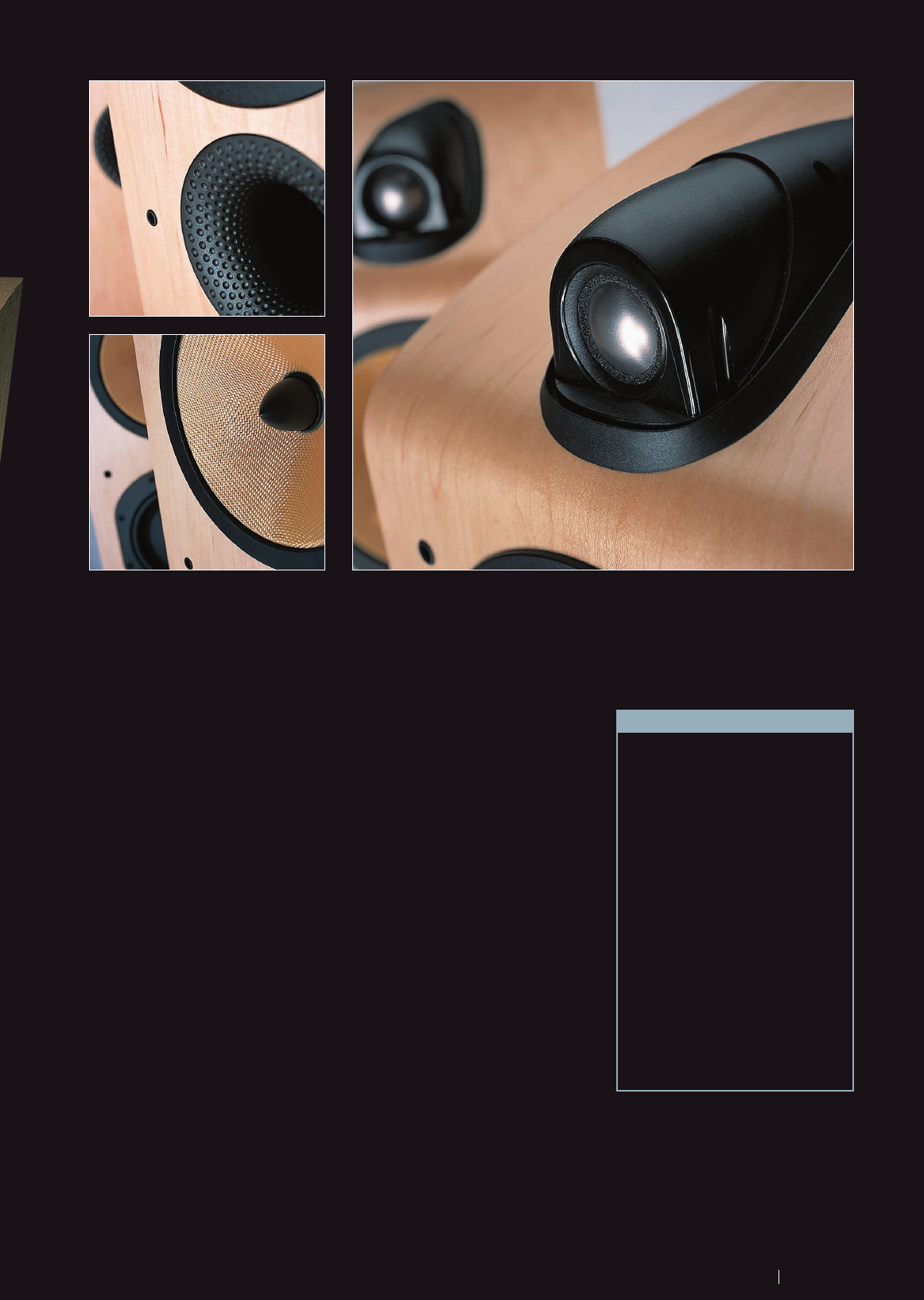
49
[
Review
]
B&W 703 loudspeaker
pioneered by the more upmarket Nautilus
models, and which provides one of the better
reasons for adopting the extra complexity of a
three-way, as distinct from the two-and-a-half-
way configuration used in the 704.
In the vast majority of three-ways, the
midrange driver is either the same as, or a
scaled down version of, the bass driver.
However, the essential difference between a
midrange-only unit and any unit required to
produce bass (whether bass-only or bass/mid)
is that a mid-only driver doesn’t undergo
significant cone excursion.
Whereas the rubber roll surround at the
edge of a driver cone normally has to centre
the cone, absorb edge-of-cone vibration and
permit generous fore ’n’ aft excursion, a mid-
only driver has no need for the last of these.
B&W has therefore come up with a midrange
driver with a heavy but unfixed surround that
locates the cone but ignores excursion in
order to optimise the vibration absorption
characteristics, by using a heavy rubber gasket
in place of the usual roll. The result, allegedly,
is improvement in dynamic range resolution.
Thanks to relatively new Klippel distortion
measuring apparatus, all the drive units have
undergone significant improvements over
their predecessors. B&W calls the techniques
it has used to make the drive unit magnetic
fields more symmetrical and minimise
variations in inductance ‘balanced drive’. The
high frequency extension of the external
tube-loaded tweeter has also been improved,
avoiding any need for a ‘super-tweeter’.
There are two bass drivers here, port-loaded
and operating in tandem, and each with
november 2003 HI-FI CHOICE
Kevlar-reinforced paper cones 120mm in
diameter. The FST midrange has B&W’s
familiar yellow woven Kevlar cone, 140mm in
diameter, while the tweeter has a 25mm alloy
dome. Just two pairs of terminals are fitted,
conveniently low down near the floor.
SOUND QUALITY
Not unexpectedly, in-room measurements
pointed towards free-space siting for this
substantial floorstander, though the bass
alignment is relatively dry and bungs are
provided should close-to-wall siting be
unavoidable for domestic reasons.
First impressions came as a bit of a surprise,
especially as the Signature 805 (see p62) was
on site at the time of its arrival, allowing
immediate comparisons. The 703 is certainly
much less laid back than the baby Signature,
and actually sounds much more upfront than
any B&W in recent memory.
Indeed, the initial judgement was that this
speaker was a little too bright and edgy for its
own good, with a touch of aggression and
harshness that bordered on the unacceptable.
This opinion was reinforced by the visible
peak at around 4.5kHz, near the bottom end
of the tweeter’s operating range, which was
clearly visible on the far-field in-room traces.
While this treble strength did seem likely to
pose a problem at first, after a few days the
tendency towards harshness and aggression
seemed to have mollified quite significantly.
Our samples had apparently had a couple of
days of running in before being shipped, but
presumably this is a speaker that needs at
least a week to get properly settled down.
P
MULTICHANNEL OPTIONS
“The 703 is much less laid back than the
Signature, and actually sounds much more
upfront than any B&W in recent memory.”
B&W makes centre and surround speakers to
fit in-between and around the 703/4/5
stereo pairs for multichannel sound. The £450
HTM7 (for ‘Home Theater Monitor’) is the
centre-front. Retaining the curved top and
external tweeter, this two-way appears bulky,
but voice-matches the 703 well enough, albeit
without the latter’s slightly bright top end. (It
matches the 704 even better – probably
because it shares the same drivers.) One
crucial thing to note – the HTM7 should not
be placed on top of a large-screen TV set, as
close proximity to a large flat surface adds a
‘honky’, thickening coloration in the midband.
Coming soon, the £900 per pair DS7 surround
speaker looks potentially even more
interesting. It’s switchable between dipole and
monopole modes (the former best for movies,
the latter for music), and the change can
cleverly be effected remotely via a 12V
‘trigger’ signal from the receiver.
HFC247.bw 22/9/03 7:13 pm Page 49





